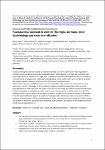Puumala Virus Outbreak in Western Thuringia, Germany, 2010: Epidemiology and Strain Identification
Faber, Mirko
Wollny, T.
Schlegel, Mathias
Wanka, K. M.
Thiel, J.
Frank, Christina
Rimek, D.
Ulrich, Rainer G.
Stark, Klaus
In 2010, the highest annual number of human Puumala virus (PUUV) infections was reported in Germany since hantavirus surveillance started in 2001. The increase in annual case numbers was especially marked in western Thuringia. We combined results of case-based hantavirus surveillance in humans and serological and molecular investigations in the rodent reservoir to describe the epidemiological situation and to identify the putative outbreak strain. A 5-fold increase in notified hantavirus cases compared to the previous annual maximum was observed in western Thuringia in 2010. Disease incidence varied tremendously within a small geographical area with case patients' places of residence clustering around beech-dominated broad leaf forest patches. Investigations in the rodent reservoir revealed a novel Puumala virus (PUUV) subtype, which is clearly distinct from strains collected in other PUUV endemic regions of Germany. It can be assumed that in regions in western Thuringia where hantavirus cases occurred in 2010 or previous outbreak years, PUUV has been present in the environment for a long time. Further studies are needed to elucidate the population dynamics and hantavirus prevalence of the rodent reservoir and driving ecological factors.
Dateien zu dieser Publikation
Keine Lizenzangabe

